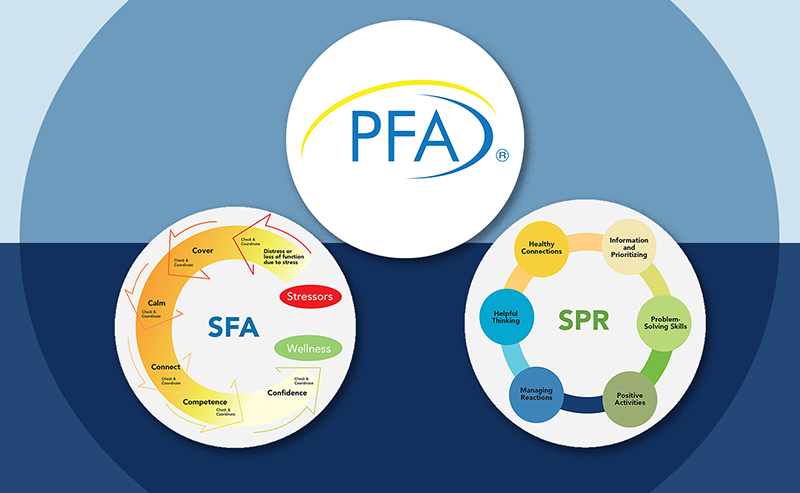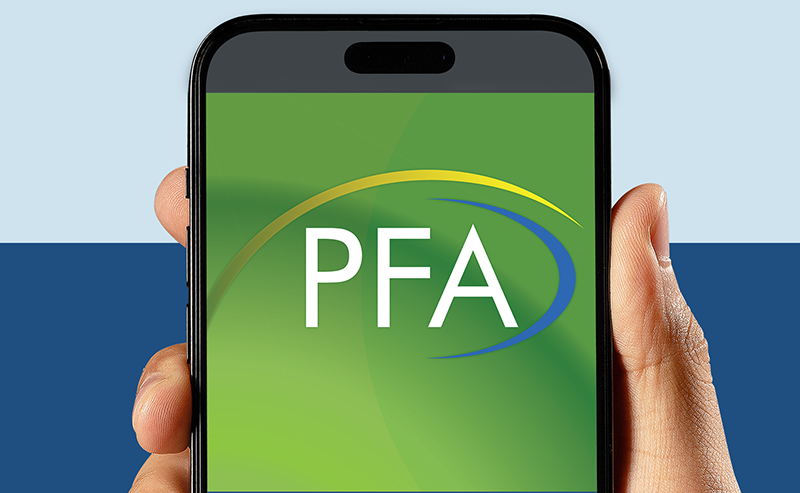PTSD: National Center for PTSD
Working with Those Affected by Disaster Events: Traumatic Stress Basics
Working with Those Affected by Disaster Events: Traumatic Stress Basics
After a disaster event, rescue workers, health care workers, journalists, and volunteers may come into contact with those affected by the event. Disaster events may be natural or human-caused disasters, mass violence, or public health emergencies, like a disease outbreak, chemical spill, or radiation emergency. Those who interact with affected individuals may do so for weeks, months, or even years after a disaster event has occurred. This contact can occur for many reasons, such as memorial services, developments in a criminal or disaster case such as (a trial after the event), or (commemorating a disaster on an anniversary). Recognizing reactions to disaster events over time by those you work with as well as yourself can benefit your work and your own self-care.
Why is it important for workers to know about traumatic stress?
Increases ability to help
It is important for those who work with people affected by disaster events to know about traumatic stress because the process of healing and recovery is ongoing. For instance, a journalist knowledgeable about traumatic stress will be more sensitive to a violent crime victim's need to be treated humanely and with respect, especially after an intentionally cruel experience.
In This Article
Approaching those affected with genuine respect, concern, and knowledge about their process increases the likelihood that you can:
- Answer some of their questions about what they may be experiencing
- Normalize their distress by letting them know that what they are experiencing is normal
- Help them to learn effective coping strategies
- Help them to be aware of possible symptoms that may require additional assistance
- Reduce their perception of helpers' potential insensitivity
- Give them a positive experience that will increase their chances of seeking help in the future
Decreases chance of doing harm
It is important to keep in mind that pressing someone into discussion of a traumatic event soon after exposure may have a detrimental effect on some traumatized individuals. While some affected by disaster events prefer to discuss their experience, overriding a reluctant individual's need: (1) for distance, (2) to avoid reminders of the trauma, and (3) to dissociate in the immediate phase of a trauma, particularly in situations where bereavement is involved, may be associated with increased risk for developing PTSD in some individuals. This is particularly true for those with heightened distress. Experts on traumatic stress emphasize that people have their own pace for processing trauma, and it is important for helpers to let those affected by disasters know that they should listen to and honor their own inner pace.
Increases self-care
Another reason why it is important to know about traumatic stress is so you can apply this knowledge to yourself. While many individuals who work with people affected by disaster events experience an enhanced sense of meaning, self-esteem, respect for the strength of others, and connection with humanity, research is beginning to show that for some individuals, this work may, under certain conditions, have negative effects. Those who work in disaster response and recovery may begin to show signs of stress disorders ranging from difficulty sleeping to PTSD symptoms such as intrusive thoughts, avoidance, and heightened reactivity. While this area of research is relatively new, researchers have coined a number of terms to describe the effects of working with trauma. These terms are described below to explain the changes workers may observe in themselves as a result of experiencing disaster events or witnessing the effects of those events on others.
Burnout
The term "burnout" has been applied across helping professions and refers to the cumulative psychological strain of working with many different stressors. It often manifests as a gradual wearing down over time.
The factors contributing to burnout include:
- Professional isolation
- Emotional drain from empathizing
- Difficult client population
- Long hours with few resources
- Ambiguous success
- Unreciprocated giving and attentiveness
- Failure to live up to one's own expectations for effecting positive change
The symptoms of burnout include:
- Depression
- Cynicism
- Boredom
- Loss of compassion
- Discouragement
Secondary traumatic stress
The term "Secondary Traumatic Stress" has been coined by various authors (1) to describe professional workers' subclinical or clinical signs and symptoms of PTSD that mirror those experienced by trauma clients, friends, or family members. While it is not recognized by current psychiatric standards as a clinical disorder, many clinicians note that those who witness traumatic stress in others may develop symptoms similar to or associated with PTSD. These symptoms include:
- Hyperarousal (heightened reactivity - startle, heart rate, pulse)
- Intrusive symptoms
- Avoidance or emotional "numbing"
- Anxiety
- Depression
Compassion stress
Charles Figley (2) coined this term as a "non-clinical, non-pathological" way to characterize the stress of helping or wanting to help a someone affected by a disaster event. Compassion stress is seen as a natural outcome of knowing about trauma experienced by a client, friend, or family member, rather than a pathological process. It can be of sudden onset, and the symptoms include:
- Helplessness
- Confusion
- Isolation
- Secondary traumatic stress symptoms
Compassion fatigue
Compassion fatigue, also coined by Figley, is considered a more severe example of cumulative compassion stress. It is a defined as "a state of exhaustion and dysfunction, biologically, physiologically, and emotionally, as a result of prolonged exposure to compassion stress" (2).
Vicarious traumatization
Vicarious traumatization was coined by Pearlman and Saakvitne (3) to describe those permanently transformative, inevitable changes that result from doing therapeutic work with trauma survivors. In their research, they noted that a number of changes were common among those mental health workers who had clients who were affected by trauma, including disaster events. The changes were considered not pathological, as described for secondary traumatic stress, and were seen instead as normal cognitive or emotional changes relating to how the mental health worker felt and thought about themself. The changes were cumulative as, over time, the mental health workers served several people or communities impacted by trauma. The changes were also pervasive in their effects on an individual's life. These changes tended to occur more often in highly empathic, sensitive individuals, those with a previous history of trauma, and newer therapists.
Secondary stress can lead to challenges including:
- Relationship with meaning and hope
- Ability to get one's psychological needs met
- Intelligence
- Willpower
- Sense of humor
- Ability to protect oneself
- Memory/Imagery
- Existential sense of connection to others
- Self-capacities, including:
- The enduring ability to maintain a steady sense of self
- Tolerance for a range of emotional reactions in one's self and others
- A sense of inner connection to others
- A sense of self as viable, worth loving, deserving
- A sense of self that is grounded
There are a number of possible behavioral changes that might result from vicarious traumatization, including:
- Becoming judgmental of others
- Tuning out
- Having a reduced sense of connection with loved ones and colleagues
- Becoming cynical or angry and losing hope or a sense of meaning
- Developing rescue fantasies, becoming overinvolved, taking on others' problems
- Developing overly rigid, strict boundaries
- Feeling heightened protectiveness as a result of a decreased sense of the safety of loved ones
- Avoiding social contact
- Avoiding work contact
If you recognize these changes in yourself
It is recommended that an individual take steps toward self-care and lifestyle balance if they are experiencing symptoms of burnout, secondary stress, or vicarious traumatization. These steps are defined in For Health Care Workers: Managing Stress from Disaster Events and are useful for those outside of the health care field.
Compassion satisfaction
It is important to note that while the information above focuses on the possible negative effects one might experience when working with trauma survivors, there is also the possibility of a powerful sense of satisfaction with this work. Figley has coined the term "Compassion Satisfaction" to describe this process, which involves the development over time of a much stronger:
- Sense of strength
- Self-knowledge
- Confidence
- Sense of meaning
- Spiritual connection
- Respect for human resiliency
Individuals who have worked with those affected by trauma, including disaster events over time, may experience negative effects during times of heavier workloads, heightened personal stress, and overwhelming exposure difficult events and their aftereffects. However, a large majority of individuals who work in disaster rescue and response indicate that it has brought great meaning into their lives, increased their sense of purpose and strength, and heightened their sense of connection with others.
References
- Stamm, B. H. (Ed.). (1995). Secondary traumatic stress: Self-care issues for clinicians, researchers, and educators. Lutherville, Maryland: Sidran Press.
- Figley, C. R. (Ed.). (1995). Compassion fatigue: Coping with secondary traumatic stress disorder in those who treat the traumatized. New York: Brunner/Mazel.
- Pearlman, L. A., & Saakvitne, K. W. (1995). Trauma and the therapist: Countertransference and vicarious traumatization in psychotherapy with incest survivors. New York: Norton.
You May Also Be Interested In


























